 Menu
Menu
Posted: May 28, 2020
Need visualization of how the Army Corps’ storm surge protection wall would look in your neighborhood or favorite spot in Charleston? Us too! Our friend and colleague Jared Bramblett has developed some excellent scaled renderings to help us all better visualize how a protective wall would interface with the community from key vistas throughout the peninsula. We divided the peninsula’s perimeter into distinct “character areas” to drill down as locally as possible, and then he created these images from certain vantage points to represent what the wall might look like from that specific location.
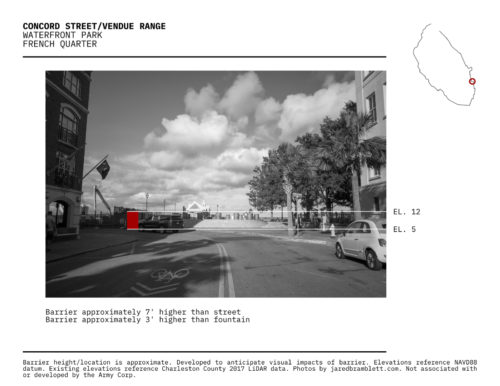
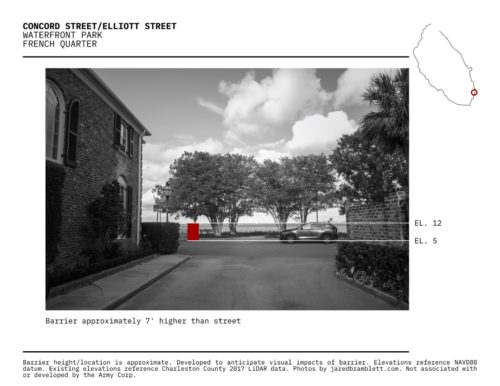
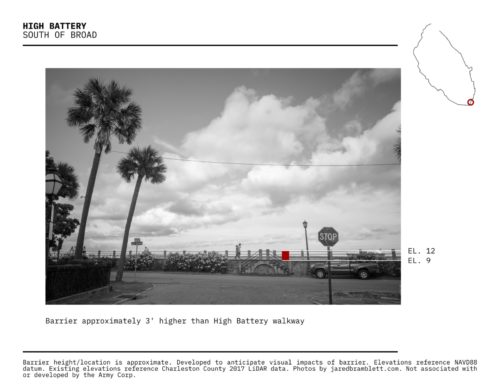
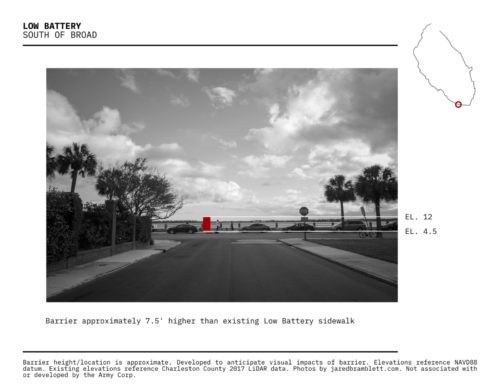
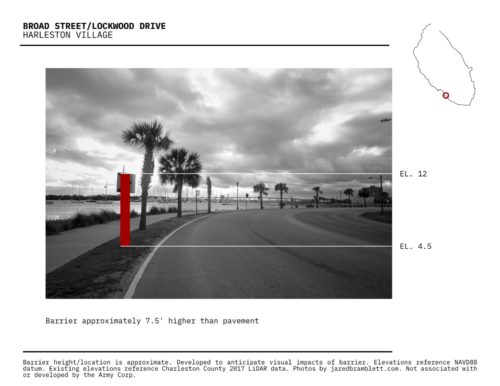
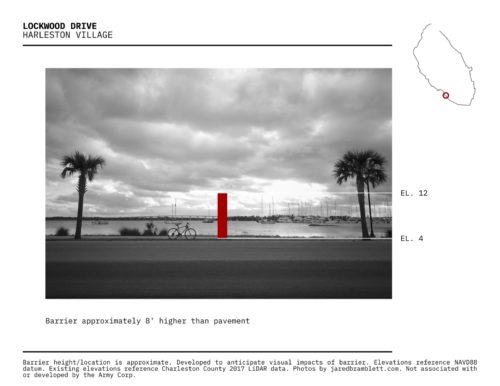
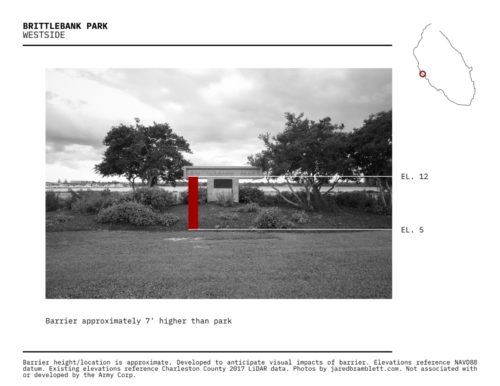
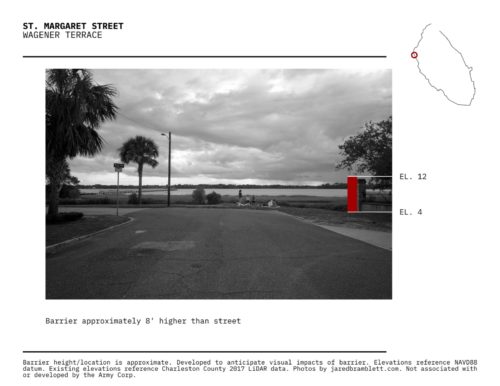
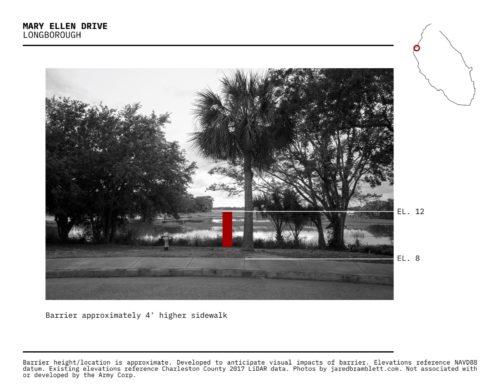
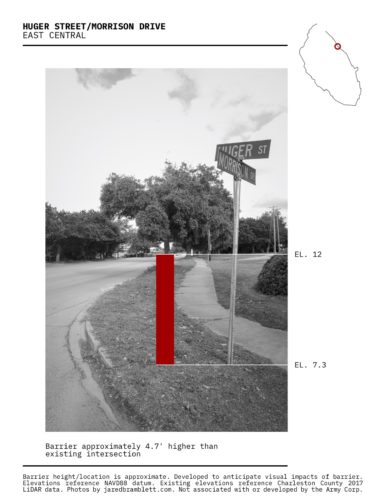
The walls and blocked view are much better than flooded historic buildings, loss of the lives and continual water in the streets.
Hopefully we will be able to walk on all of the walls.
The view that we currently see is no longer a source of enjoyment but a growing source of anxiety. I would gladly enjoy a barrier we can all access for strolling safely along the waterfront. If anyone can offer a better alternative that doesn’t include raising historic structures six to ten feet, which still doesn’t address the flooded roads and intersections, I’m listening.
The visualizations of barrier heights is helpful to the discussion as people can really start to understand the overall impact of what is being proposed, but it is not enough. This graphical approach needs to be taken further as I truly believe people do not fully understand the significant change this proposal means to the landscape of the Peninsula and our relationship with our rivers and harbor every day. Why didn’t the Corps of Engineers include graphical renderings of what they are proposing? People need to read the full proposal and be informed. The proposal will not stop water from flooding our streets or buildings. It is a single purpose design attempting to stop storm water surge only. That scenario is only one factor in a much longer list of issues that lie at the root of the flooding. Trying to solve a multi variable problem through a single variable solution is a fool’s folly. The only certainty of the barrier wall approach is that we lose what it means to live on the Peninsula in the hope it will stop a storm water surge event – and this hope comes with a hefty price tag. This is the kind of engineering proposal you get when you aren’t asking the right questions at the start of the process.
Please answer:
1. When the ACE uses a lower projected sea level rise number than the City uses, who is more accurate and how will using the lower number affect effectiveness of wall?
2. Re. the high-density residential Area (340 homes) surrounding Gadsdenborough Park, which flooded to the height of a parking meter in the 2017 hurricane, why does ACE leave this area outside the wall protection? Even when living quarters are 2nd floor, flooded lobbies, garages, streets are still a serious problem for accessibility and livability. Many if not most residents are senior citizens who are often physically challenged. This area also includes IAAM, aquarium, Ft. Sumter boats, and maritime center. Why isn’t this area given wall protection? Especially since wall around battery will push diverted waters up rivers, making flooding worse in this unprotected area?
3. If ACE wall only addresses storm surge and it proves, over time, to be inadequate for sea level rise, then what will be needed to save City from flooding? Both need to be addressed together now.
Tommie,
Thank you. You raise valid concerns. Questions 1 and 2 are questions that we have also, and we are including in our public comments to the Corps. You can learn more about some of the questions and concerns we’ve initially raised to include in our public comments at the blog post linked below.
https://www.historiccharleston.org/blog/hcf-continues-to-refine-position-on-army-corps-perimeter-protection-plan/
Regarding your Question 3, we are working very hard to ensure that the perimeter protection system being studied by the Corps aligns with the recommendations made in the Dutch Dialogues Charleston, which was adopted by City Council as guiding policy for the City in January. Any project of this nature should adhere to our City’s overall flooding strategy and create a pathway to resilience that will protect and save our City from both storm surge and sea level rise.
I believe that the bathtub effect is a real concern and that there are very few considerations in the Corps of Engineer proposal for a range of items that address the sea level rise such as those possibilities that were outlined in the Dutch Dialogues. In fact, who is marrying those concepts with the Corps of Engineers proposal. Or are we stuck with the Corps options only? For the choices to be laid out relative to views out seems impractical and without merit since it does not offer what options might be available through more suitable means using a strategy such as slow, store, drain. Furthermore, a wall does nothing to advance any long term solution but is likely to have unintended consequences. And the Corps levees in New Orleans did nothing to prevent the devastation of Katrina. How do the filled lands throughout the peninsula impact the flooding issues? The base map used by Halsey is part of the 1883 map of Charleston. And frankly, no walls have ever been particularly effective on their own to keep out anything…
Design walls to be interactive, interpretive sites – integrated with active/passive recreational spaces